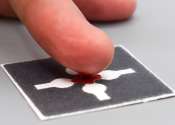Colloidal gold, also known as "nanogold", is a suspension (or colloid) of sub-micrometre-sized particles of gold in a fluid — usually water. The liquid is usually either an intense red colour (for particles less than 100 nm), or a dirty yellowish colour (for larger particles). The nanoparticles themselves can come in a variety of shapes. Spheres, rods, cubes, and caps are some of the more frequently observed ones.
Known since ancient times, the synthesis of colloidal gold was originally used as a method of staining glass. Modern scientific evaluation of colloidal gold did not begin until Michael Faraday's work of the 1850s. Due to the unique optical, electronic, and molecular-recognition properties of gold nanoparticles, they are the subject of substantial research, with applications in a wide variety of areas, including electronics, nanotechnology, and the synthesis of novel[peacock term] materials with unique properties.[peacock term]









